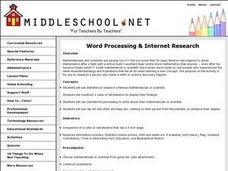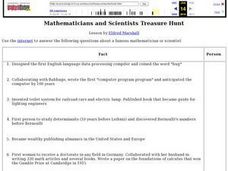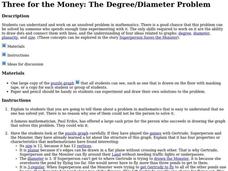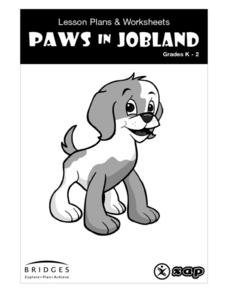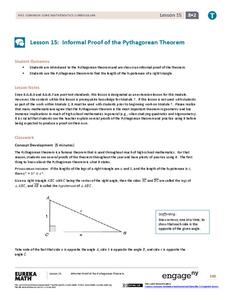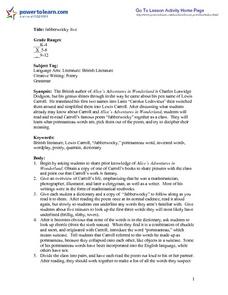Google
History of Math Lesson Plan
Learners honor mathematicians who have contributed important discoveries throughout history by researching and creating a report about a famous mathematician and their contributions to the history of mathematics. Pairs of learners create...
Curated OER
Mathematicians Research Projects
Students research a famous mathematician and create a presentation of their research. In this famous mathematician research instructional activity, students decide on a famous mathematician that they would like to learn more about. They...
Curated OER
Famous Mathematicians/Database
Students analyze a math database and uncover facts. For this algebra lesson, students investigate the lives of famous mathematicians using facts they find about the different authors. They gain a new perspective for the mathematicians...
Curated OER
A Fun Way to Learn Math History!
Ninth graders, in groups, search for and locate resources on a chosen famous mathematician. Enough information needs to be gathered to examine the mathematician's life and his/her contributions to the field of mathematics.
Curated OER
Happy Birthday Mathematicians and Me
Students choose a mathematician or scientist born on the same day as the student and research them. They create a cube or tetrahedron and place required information on the sides (such as birth year, death yr., greatest contribution to...
Curated OER
Mathematicians
Students explore famous mathematicians. In this mathematician lesson, students investigate for a mathematician who share their birthday and research their accomplishments in math.
Curated OER
Sharing Your Birthday
Students use the Internet to locate a famous mathematician who happens to share his or her own birthday. Using an imbedded worksheet, they then answer a series of questions about the mathematician and then write a short summary.
Benjamin Banneker Association
Celebrate Benjamin Banneker
Inventor, astronomer, surveyor, mathematician, clock maker. Learners celebrate the life of Benjamin Banneker by building creative analog clocks, making scale models, and solving problems related to surveying. The activities model the...
Curated OER
Mathematicians and Scientists Treasure Hunt
In this Mathematicians and Scientists Treasure Hunt worksheet, students use the internet to research facts about a famous mathematician or scientists. Students read the fact on the worksheet and write the name of the famous individual...
Curated OER
Mathematicians are People, Too!
Students access the Internet to locate data regarding their assigned mathematician. They organize their notes on a data form, write a report, create a visual and present their facts to their classmates.
PBS
The History and Use of Sampling Methods
Young mathematicians define population, draw convenience sample from the population, draw quota sample from the population, and draw random probability sample from the population. They explain why a random probability sample usually...
Curated OER
Flying with Pythagoras
A lengthy narrative about Pythagoras and his students precedes an activity in which your young mathematicians practice using the Pythagorean theorem to solve three problems about flight and distance. Answers are provided.
Curated OER
Design a Stamp
Students research a famous scientist or mathematician, design a stamp to honor their work, and write persuasively about why this person and their work should be honored on a stamp.
Curated OER
Database Lesson
Students access the Internet to locate data regarding their assigned mathematician. They organize their notes onto a data form, then enter it into a database, and sort the database according to given criteria.
EngageNY
The Power of Algebra—Finding Primes
Banks are responsible for keeping our financial information safe. Mathematics is what allows them to do just that! Pupils learn the math behind the cryptography that banks rely on. Using polynomial identities, learners reproduce the...
Curated OER
Have a Ball with Bernoulli II
Third graders explore the work of Daniel Bernoulli through experiment and background information. In this Bernoulli lesson plan, 3rd graders participate in air pressure experiments. Students record their observations of the effects of...
Curated OER
Three for the Money: The Degree/Diameter Problem
Students explore the degree, diameter, planarity, and size of graphs. In this degree, diameter, planarity, and size of graphs lesson, students try to construct a graph with more than 12 vertices that satisfy all other requirements. ...
Curated OER
The Hardy-Weinberg Equilibrium
Students act out a drama in this lesson on one aspect of the Hardy-Weinberg Equilibrium. They are to follow all stage directions precisely and give it their best effort to get across the main points of the play.
Curated OER
Categories of Mathematics Occupation
Second graders explore careers in mathematics. In this careers lesson, the teacher leads a discussion about occupations that require math, then students create a short skit about a job that uses math. Lesson includes extension ideas.
EngageNY
Informal Proof of the Pythagorean Theorem
Prove the Pythagorean Theorem using multiple informal proofs. Scholars first develop an understanding of the origins of the Pythagorean Theorem through proofs. They round out the lesson by using the theorem to find missing side lengths...
Curated OER
Exploring Special Lines
Learners compare and order numbers. In this geometry lesson, students write equations for inequalities. They differentiate and apply concepts of triangular properties to solve problems.
Curated OER
Building Biographies: A Research Unit
Students explore the fundamental principles involved in completing a research project. Several handheld technical pieces of equipment are utilized to complete this activity.
Curated OER
"Jabberwocky" Jive
Pupils review the fantasy of Alice in Wonderland and discuss the author. After reading the poem, "Jabberwocky," they look up unfamiliar words in the dictionary. Working as partners, they create a list of "protmanteau" or invented words...
Curated OER
e, pi, and Exponential Functions
Students investigate e, pi and exponents. In this calculus instructional activity, students define constants and non-constants using, pi, e and exponents as an example. They use the TI to work the problems in this instructional activity.






